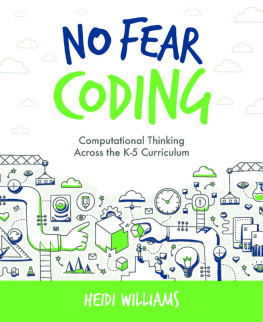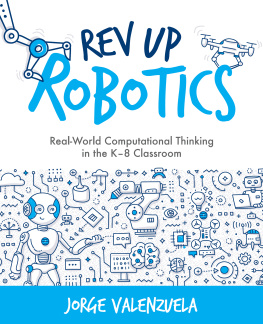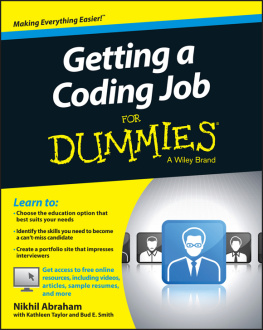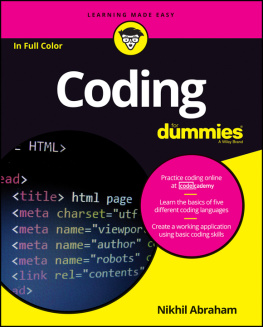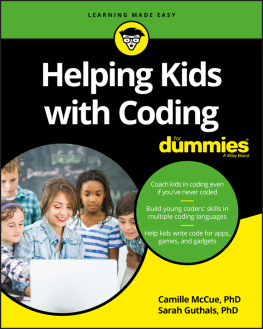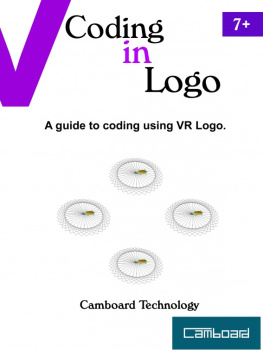Contents
Pagebreaks of the print version
Guide


No Fear Coding
Computational Thinking Across the K5 Curriculum
Heidi Williams
2017 International Society for Technology in Education
World rights reserved. No part of this book may be reproduced or transmitted in any form or by any meanselectronic, mechanical, photocopying, recording, or by any information storage or retrieval systemwithout prior written permission from the publisher. Contact Permissions Editor: ; fax: 1.541.302.3780.
Editor: Emily Reed
Copy Editor: Kristin Landon
Book Design and Production: Jeff Puda
Cover Design: Edwin Ouellette
Library of Congress Cataloging-in-Publication Data
Names: Williams, Heidi, author.
Title: No fear coding: computational thinking across the K-5 curriculum / Heidi Williams.
Description: Portland, Oregon: International Society for Technology in Education, [2017] | Includes bibliographical references.
Identifiers: LCCN 2017015205 (print) | LCCN 2017024184 (ebook) | ISBN 9781564846259 (mobi) | ISBN 9781564846266 (epub) | ISBN 9781564846273 (pdf) | ISBN 9781564843876 (pbk.)
Subjects: LCSH: Computer science--Study and teaching (Elementary) | Computer programming--Study and teaching (Elementary)
Classification: LCC QA76.27 (ebook) | LCC QA76.27.W38 2017 (print) | DDC 004.071--dc23
LC record available at https://lccn.loc.gov/2017015205
First Edition
ISBN: 978-1-56484-387-6
Ebook version available.
Printed in the United States of America
ISTE is a registered trademark of the International Society for Technology in Education.
About ISTE
The International Society for Technology in Education (ISTE) is the premier nonprofit organization serving educators and education leaders committed to empowering connected learners in a connected world. ISTE serves more than 100,000 education stakeholders throughout the world.
ISTEs innovative offerings include the ISTE Conference & Expo, one of the biggest, most comprehensive edtech events in the worldas well as the widely adopted ISTE Standards for learning, teaching and leading in the digital age and a robust suite of professional learning resources, including webinars, online courses, consulting services for schools and districts, books, and peer-reviewed journals and publications. Visit iste.org to learn more.
Related ISTE Titles
Make, Learn, Succeed: Building a Culture of Creativity in Your School, by Mark Gura (2016)
To see all books available from ISTE, please visit iste.org/resources.
About the Author

Heidi Williams is head of school for Jefferson Lighthouse, an IB (International Baccalaureate) Primary Years World School in Racine, Wisconsin. Williams is also known as the STRETCh (Striving to Reach Every Talented Child) Instructor www.stretchinstructor.com and has worked in the area of Gifted and Talented as a differentiation specialist and a K12 GT Coordinator. She has a bachelors degree in elementary education, a masters degree in curriculum and istruction, certificates in online teaching and coaching, and educational leadership licenses for principal and director of curriculum and instruction. She has presented at numerous local, state, and national conferences on the topics of differentiation and the use of technology to enhance learning. Her passions include the latest research in neuroscience and unlocking the doors of learning for students across the world. She lives in Wisconsin and has four beautiful daughters, as well as a devoted and loving husband.
Contributors
Catherine Castillo is a K5 learning coach for Springfield Public Schools in Springfield, Missouri. She was a K5 numeracy coach for six years and has served as a classroom teacher and a summer school administrator. Her passions are coding in the classroom, integration of STEM activities, and personalizing learning. Catherine holds masters degrees in curriculum and instruction and educational leadership. She regularly presents at local, state, and national conferences on a variety of math and STEM topics. Catherine lives in Springfield, Missouri with her two sons and their dog Isengard.
Vivian Chezvivian is Canadian-born, of Chinese descent, and currently living in Switzerland. She is an elementary school classroom generalist but has also taught as a music specialist, in ESL/EAL and also in Learning Support. She is a Coetail Post-Graduate Certificate grad and a former Coetail Coach. Her blog (www.coetail.com/chezvivian) curates her assignments for Coetail, her graduate studies in educational technology integration, and anything else education related that she feels inspired to write about.
Traci Kopeki is inspired to teach the whole student by using a variety of learning and technology platforms and incorporating students differing learning styles. She would like to thank Heidi Williams for helping her open the doors to new ideas on learning. Not only has she been inspired to do this with her students, her three boys have kept her creatively thinking about how to learn in different ways. A fan of walking, biking, downhill skiing, and boating, Traci loves to get outside everyday. She lives in Wisconsin.
Karen North is a retired computer science, math, and career and technical education (CATE) teacher with 30 years experience in public schools. She is a CS4TX.org leader, a Code.org affiliate, NCWIT Houston Aspirations coordinator, AAUW Expanding Your Horizons Conference coordinator, ISTE Computing Teachers Network officer, and a Code Buddy for Spring Branch ISD in Houston. Karen was honored as a White House Champion of Change for CS education in January 2016 for her advocacy work and online presence since 1985.
Acknowledgements
The author and editor would like to thank the contributors for their time and dedication and the many reviewers for their insightful comments. This book would not have been possible without the support and encouragement of Joseph Kmoch and the involvement of the ISTE Computing Teachers Network. This community actively works to encourage the teaching of computer science in PK12 and to advance educators skills and expertise in the area of computer science. To learn more about ISTE communities and membership visit iste.org/join.
Foreword
In his 2009 TED Talk, How Great Leaders Inspire Action, Simon Sinek introduced a powerful model for inspirational leadership that begins with asking the Why. He explains that most organizations and companies know what they do and how they do it, but less clear is why they do what they do. Simon discovered a pattern in how great leaders and organizations think, act, and communicate. He coined it the Golden Circle.
Using the Golden Circle, successful organizations begin by exploring the Whythe purpose, belief, or reason for doing something. The Why informs the processes we take to reach our desired result. Educators can employ this same thinking by asking themselves why they embarked on a career in education. Answers to this question will vary but might include things like, to help students succeed in their lives and careers or even, to make the world a better place.

